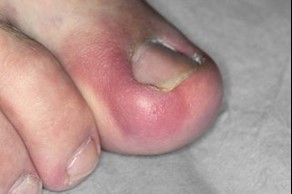What is an ingrown toenail?
As a portion of nail punctures the surrounding skin it can cause pain, inflammation and at times infection. This is known as an ingrown toenail and is a common complaint that can be treated effectively by a Podiatrist.

Further information on ingrown toenails
Why does this happen?
There are many reasons this can occur including:
- Cutting nails too short
- Cutting or trimming the sides of the nail where it meets the skin
- Picking toenails
- Tight or ill-fitting shoes or hosiery
- Excessive moisture (sweat)
- Damage to the nail or toe
- Fungal infection
- Increased curve of the nail.
How can I prevent this?
There are things you can do to prevent an ingrown toenail as part of your personal footcare routine. Further information and support available from our personal footcare site.
Important points to remember:
- Ensure you are using the appropriate equipment and technique when cutting your nails.
- Change socks regularly throughout the day to prevent increased moisture
- Use of cotton socks rather than wool
- Ensure footwear and hosiery are the appropriate fit (Page 17, ‘Looking after your feet’ booklet).
What do I do if I have an ingrown toenail?
If you have an ingrown toenail, and self-treatment has failed, you will require treatment by a qualified Podiatrist. To access podiatry treatment you can self-refer by contacting NHSGGC Podiatry Referral Management Centre:
Phone: 0141 347 8909 (Monday to Friday 8.00am – 8.00pm, Saturday 9.00am – 1.00pm)
What will happen at my appointment?
At your initial appointment the Podiatrist will assess your concerns, treatment options and the risks and benefits of treatments. This will allow you to make an informed choice of your treatment plan. If there is infection present the podiatrist can arrange for antibiotics to treat the infection. Treatment may be performed on the day to remove the problematic portion of nail however, in some cases you may need further treatment which may require a local anaesthetic (nail surgery). Your Podiatrist will discuss all your treatment options and will refer you for nail surgery if deemed necessary.
Nail Surgery
What is nail surgery?
Nail surgery involves removing a piece or all of a problematic toenail. The option to have the nail permanently removed or allowing it to grow back will be discussed with your Podiatrist.
What will happen at my nail surgery appointment?
Your Podiatrist will discuss your general health and it may be helpful to bring a list of your medication. If you are diabetic we advise having your HBA1C (blood sugars) checked before your procedure date. Having this information will allow you both to agree on what procedure you are best suited for. The procedure will require your toe(s) to be numb which is achieved using a local anaesthetic injection. Your Podiatrist will explain the procedure and answer any questions you may have. A family member/friend may accompany you to your appointment for support if needed.
Preparing for the appointment
- Ensure you have breakfast/lunch depending on the time of your appointment
- Bring open toe shoes (sandals, flip flops etc.) to accommodate the dressing that will be applied
- Ask of family member/friend to drive you or consider public transport. If this is not possible you may drive
- Ensure you are able to rest the foot following the procedure. The Local anaesthetic will wear off in approximately 2-3 hours, take care not to damage it while it is numb.
After the procedure
You will be provided with information to help you manage your care at home. This will include:
- Pain relief
- Dressings
- Footwear
- Activity.
Aftercare and what to expect
You will be expected to change your own dressings while the wound is healing. This will normally involve:
- Allow the dressing to get wet in the shower/bath
- Remove dressing and allow the water to run down your body and over the toe – avoid direct water pressure on the toe
- Allow the area to air dry, do not use a towel to dry the toe
- Apply a breathable dressing available from local supermarkets or pharmacies. We advise you obtain these before your procedure date
- It is important to avoid foot baths, prolonged soaking and any type of scrubbing of the area.
Healing times may vary from 4 – 12 weeks, depending on your medical history and the procedure undertaken. The application of the chemical (Phenolisation) to prevent the nail growing back will increase healing time. Normal healing from phenolisation may include:
- Redness localised to the tissues around the nail bed
- The nail bed may be moist and leak some fluid onto the dressing initially
- A thin yellow film may form over the nail bed
- Area may look slightly yellowish before getting better and looking more like a normal wound.
All of the above should reduce gradually and result in a dry scab forming with no fluid leaking onto the dressing.
Infection
It is important to monitor the area for signs and symptoms of infection and contact your local Podiatry department if you have concerns. If you follow the aftercare advice this should help prevent infection occurring. Signs that infection may be present include:
- Significant increase in redness and swelling
- Significant increase in pain and discomfort
- A foul smell from the area
- Flu like symptoms (Out of hours, contact NHS 24 on 111 if podiatry service not available).
What will it look like once healed?
If the nail has been allowed to re-grow this will normally take 3-6 months. If the aim is to prevent the nail growing back the area will heal over with normal skin that will toughen slightly over time. There is a chance the nail could grow back however this can often be managed with light regular filing or further treatment if causing significant issues.
